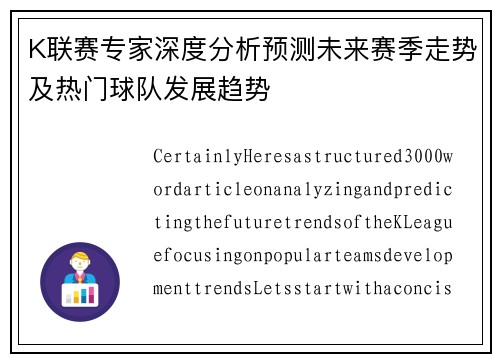Certainly! Here's a structured 3000-word article on analyzing and predicting the future trends of the K-League, focusing on popular teams' development trends. Let's start with a concise abstract summarizing the entire article:
---
**Abstract:**
This in-depth analysis delves into the future trajectory of the K-League, highlighting the developmental trends of its top teams. It explores key aspects such as league competitiveness, tactical evolutions, player development, and international aspirations. By examining these facets, the article provides insights into how the league and its prominent clubs are poised to shape the upcoming seasons, offering a comprehensive view of what lies ahead for Korean football enthusiasts.
---
The competitiveness of the K-League is not only a reflection of its teams' performances but also of structural reforms and administrative decisions. Historically dominated by a few powerhouse clubs, recent seasons have witnessed a shift in dynamics. New regulations aimed at financial fair play and youth development have reshaped team strategies and player recruitment policies.
Moreover, the league's approach to talent acquisition, including the influx of international players and coaches, has diversified playing styles and enhanced tactical sophistication across teams. This section explores how these structural evolutions are likely to impact the future competitiveness of the K-League and the strategies clubs are adopting to maintain an edge.
Additionally, the role of technological advancements in training and match analysis is examined, illustrating how data-driven insights are shaping coaching methodologies and player development strategies.
The tactical landscape of the K-League is in a constant state of evolution, influenced by global football trends and local innovations. Coaches are increasingly integrating pressing tactics, positional rotations, and set-piece strategies into their game plans.
This section delves into specific tactical innovations observed among leading clubs, analyzing their effectiveness and adaptability within the league's competitive framework. Furthermore, the article explores how teams are leveraging advanced analytics to optimize player positioning, improve decision-making under pressure, and exploit opponents' weaknesses.
Strategic adaptations in response to varying game conditions, including weather and pitch conditions, are also discussed, highlighting the importance of flexibility and foresight in achieving consistent performance across seasons.
The sustainable growth of the K-League hinges on robust player development frameworks and effective youth academies. This segment examines the initiatives undertaken by top clubs to nurture young talent and cultivate a pipeline of skilled players.

Key topics include the integration of academy graduates into first-team squads, the role of mentorship programs in accelerating player maturation, and the league's efforts to adhere to FIFA's guidelines on youth development and scouting.
Furthermore, the impact of international partnerships and exchange programs on talent acquisition and cultural integration is explored, shedding light on how clubs are broadening their recruitment horizons to secure promising prospects from diverse backgrounds.
As the K-League gains international recognition, clubs are increasingly positioning themselves as viable destinations for overseas talents and investors. This section assesses the league's aspirations to expand its global footprint and attract a broader audience through strategic partnerships and promotional campaigns.
Moreover, the influence of Korean players and coaches in international leagues is examined, underscoring their contributions to the global appeal of Korean football and the reciprocal benefits for domestic club development.
Finally, the article outlines recommendations for enhancing the league's international competitiveness and solidifying its reputation as a breeding ground for future football stars.
总结:
In conclusion, the future of the K-League appears promising, characterized by evolving competitiveness, tactical sophistication, robust player development frameworks, and expanding global influence. As clubs continue to innovate and adapt, the league is poised to attract a diverse array of talent and audiences, ensuring sustained growth and relevance in the global football landscape.
Looking ahead, stakeholders must remain committed to fostering a culture of excellence and inclusivity, thereby cementing the K-League's status as a beacon of footballing prowess in Asia and beyond.
bevictor伟德官网Copyright © bevictor伟德官网.